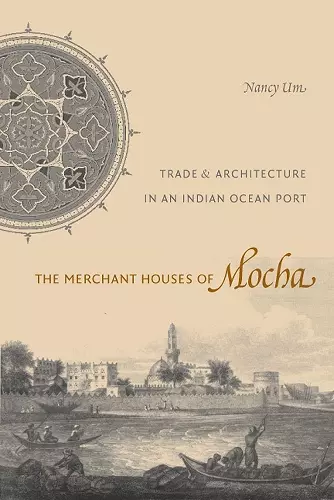The Merchant Houses of Mocha
Trade and Architecture in an Indian Ocean Port
Format:Paperback
Publisher:University of Washington Press
Published:27th Oct '09
Currently unavailable, and unfortunately no date known when it will be back
This paperback is available in another edition too:
- Hardback£91.00(9780295989105)

Um's book is at the forefront of a new, and sorely needed, re-conceptualization of the cultural functions of architecture, not only in the premodern cities of Arabia but also in the vast and relatively neglected Indian Ocean rim. -- Nasser Rabbat, MIT There is no book on a Middle Eastern city that I know of that has so many conclusions that are new ... Um's contribution is a rare achievement where politics, economics, religious affiliation, ethnic identification, patronage, architecture, and concepts of urban space are effectively combined. -- Jere Bacharach, University of Washington
Gaining prominence as a seaport under the Ottomans in the mid-1500s, the city of Mocha on the Red Sea coast of Yemen pulsed with maritime commerce. This book tells how and why Mocha's urban shape and architecture took the forms they did.
Gaining prominence as a seaport under the Ottomans in the mid-1500s, the city of Mocha on the Red Sea coast of Yemen pulsed with maritime commerce. Its very name became synonymous with Yemen's most important revenue-producing crop -- coffee. After the imams of the Qasimi dynasty ousted the Ottomans in 1635, Mocha's trade turned eastward toward the Indian Ocean and coastal India. Merchants and shipowners from Asian, African, and European shores flocked to the city to trade in Arabian coffee and aromatics, Indian textiles, Asian spices, and silver from the New World.
Nancy Um tells how and why Mocha's urban shape and architecture took the forms they did. Mocha was a hub in a great trade network encompassing overseas cities, agricultural hinterlands, and inland market centers. All these connected places, together with the functional demands of commerce in the city, the social stratification of its residents, and the imam's desire for wealth, contributed to Mocha's architectural and urban form.
Eventually, in the mid-1800s, the Ottomans regained control over Yemen and abandoned Mocha as their coastal base. Its trade and its population diminished and its magnificent buildings began to crumble, until few traces are left of them today. This book helps bring Mocha to life once again.
"Um demonstrates that Mocha's urban history is much richer than its link to a single commercial product. . . . Scholars like Um are breaking the unfortunate but long-lasting misassumption that pre-modern Arabian history is stagnant and devoid of source material."
-- Molly Patterson * MESA *"Um's call for a wider reexamining of secular architecture . . . is all the more resounding for her own contribution that so clearly demonstrates the possibilities and value of such an undertaking."
-- Sebastian R. Prange * Comparative Studies of South Asia, Africa, and the Middle East *"Her treatment of Mocha, often presented in the context of engaging and insightful comparative data, offers a refreshing examination of the city's urban and architectural history, which sheds considerable light on social and commercial history. . . . Um's study is based on a variety of sources—architectural, archival, and literary—that she wields effectively. . . . The Merchant Houses of Mocha is a valuable contribution to the growing number of recent studies on particular localities within the Red Sea . . . all of which are refining and refashioning our understanding of a poorly understood but important region that connected the worlds of the Middle East, South Asia, and East Africa."
* International Journal of Middle Eastern Studies *"With her study of Mocha in the period between 1650 and 1750, Nancy Um has broken new ground through an innovative combination of architectural and archival materials, thus combining the approaches of historian and art historian in a unique way. . . . [H]er important contribution to debates on port cities in the Red Sea and Indian Ocean with regard to their functioning and relation to sea and hinterland, as well as to debates on architectural history, will surely have a major impact on how we understand urban history on the Arabian Peninsula and beyond. This unusually well-written work deserves a place on reading lists in art history, the history of the Arabian Peninsula as well as the history of the Red Sea and Indian Ocean, and port cities in general."
* Bulletin of the School of Oriental and African Studies *"Rather than offering the reader a linear framework for understanding the development of Mocha's premodern urban history, Um weaves together many different historical narratives and maps them onto the city itself. . . . Scholars like Um are breaking the unfortunate but long-lasting misassumption that pre-modern Arabian history is stagnant and devoid of source material."
* Review of Middle Eastern Studies (RoMES) *"This book deserves to be widely read, and praised. Um demonstrates familiarity with a host of secondary work in urban history, and where necessary challenges and modifies them. Her use of architecture as a key source is extremely innovative. In terms of Indian Ocean studies, we now have a few foundational studies . . . which sketch broad themes. We need many more micro-studies which can modify received wisdom. Um's book is an exemplary case study of what we need, and . . . in its use of difficult sources, and its successful analysis."
* IIISBN: 9780295989112
Dimensions: unknown
Weight: 408g
272 pages